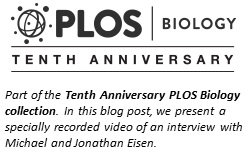Naïve, Crazy Idealists Make Good
 Ten years ago this month, PLOS ventured into the world of scientific publishing by launching its flagship journal, PLOS Biology. When Harold Varmus, Pat Brown, and Michael Eisen founded PLOS in 2000, they did so with the grand vision of making the vast stores of scientific information available to anyone with an interest—teachers, students, physicians, patients, scientists, and the general public—who didn’t have access to a research library or couldn’t afford to pay for journal subscriptions.
Ten years ago this month, PLOS ventured into the world of scientific publishing by launching its flagship journal, PLOS Biology. When Harold Varmus, Pat Brown, and Michael Eisen founded PLOS in 2000, they did so with the grand vision of making the vast stores of scientific information available to anyone with an interest—teachers, students, physicians, patients, scientists, and the general public—who didn’t have access to a research library or couldn’t afford to pay for journal subscriptions.
Frustrated by the unwillingness of publishers to make their content freely available without restriction, the founders decided to become publishers to show the world how it could be done. As they explained in their editorial in PLOS Biology’s inaugural issue: “Our aim is to catalyze a revolution in scientific publishing by providing a compelling demonstration of the value and feasibility of open-access publication.”
To mark the occasion of PLOS Biology’s 10th anniversary, we asked co-founder Michael Eisen and his brother, Jonathan Eisen, who has served first as Academic Editor-in-Chief of PLOS Biology and now as Chair of the Advisory Board for the journal, to reflect on the early days of PLOS and PLOS Biology, open access, and the future of scientific publishing.
“Ten years ago, everybody said it wasn’t going to make it a year,” Michael Eisen says. “I don’t think anybody thought that PLOS or PLOS Biology would still be around after a decade. They thought we were naïve, crazy idealists who were playing around with some foundation’s money to start a journal.”
“Have we accomplished everything we wanted to accomplish 10 years ago? No. Have we fundamentally changed the way people think about science publishing? I think the answer is yes.”
 See the Tenth Anniversary PLOS Biology Collection or read Biologue blog posts highlighting our ten selected articles.
See the Tenth Anniversary PLOS Biology Collection or read Biologue blog posts highlighting our ten selected articles.
